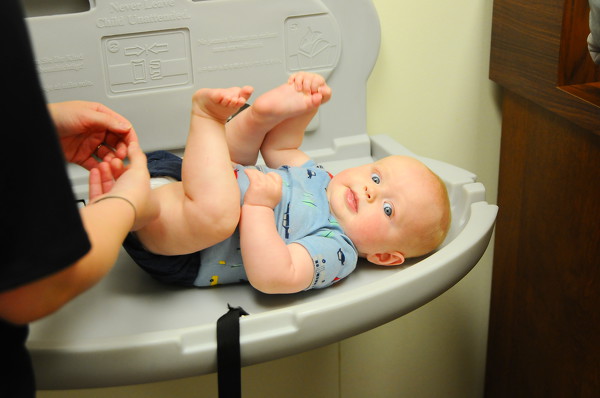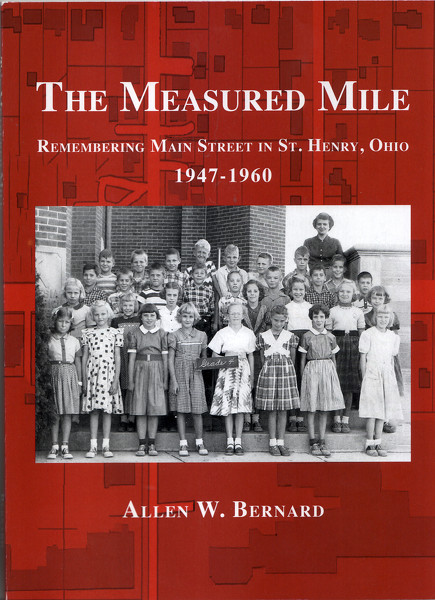
A 6-month-old boy receives two shots during a visit to the Mercer County District Health Department on Thursday evening. Infants and children under the age of 5 are at high risk for severe illness and complications from measles, making community immunity against the disease imperative, officials said.
CELINA - Mercer County Health District Director of Nursing and Communicable Disease Coordinator Julia Shaffer is spreading the word about immunization rates in Mercer County as the national measles outbreak continues to spread.
Measles is a highly contagious, vaccine-preventable disease that causes high fever, cough, runny nose and red, watery eyes. A rash of tiny red spots breaks out three-five days after symptoms begin. It also can lead to pneumonia and brain swelling, which can lead to seizures, brain damage or death.
Ohio has not yet had a known case of measles, but neighboring states Indiana, Kentucky, Michigan and Pennsylvania have reported cases. According to the Centers for Disease Control and Prevention, 1,044 cases of measles have been confirmed in 28 states from Jan. 1-June 13. This is the greatest number of cases reported in the U.S. since 1992. The disease was declared eliminated in the United States in 2000.
Measles is often brought into the United States by unvaccinated travelers who get it while they are in other countries. Anyone who is not protected against the disease is at risk.
People at high risk for severe illness and complications from measles include infants and children under the age of 5, adults over the age of 20, pregnant women and people with compromised immune systems, such as those with leukemia or HIV infection. Especially in babies and young children, measles can lead to lung infections, brain damage, deafness or death. About 1 in 5 people in the U.S. who get measles will be hospitalized, according to the CDC.
Measles is so contagious that if one person has it, up to 9 out of 10 people around that person will also become infected if they are not protected, the CDC says.
Unvaccinated people can get the disease just by being in a room in which a person with measles has been, even up to two hours after that person has left. The CDC continues, saying infected people can spread the disease to others even before knowing they have it, from four days before developing the rash through four days afterward.
Shaffer and other medical health professionals are working to defend vaccines and combat the spread of misinformation regarding vaccines. According to an article provided by the Mercer County Health District, the modern version of today's anti-vaccination movement began in response to a 1998 article in the Lancet alleging that the MMR vaccine, which protects against measles, mumps and rubella, causes autism.
Although the paper was subsequently retracted, anti-vaccine sentiments amplified through the 2000s on the internet and has evolved into its own media empire, with at least 480 anti-vaccine websites that are routinely amplified by the likes of Facebook and Twitter, according to the article. According to the CDC, at least 100,000 children in the United States are fully unvaccinated.
A nationwide cohort study published this year following more than 650,000 children in Denmark confirmed kids have no increased risk for autism after the MMR vaccination, including in children with autism risk factors as defined by a sibling history of autism. An international collaboration led by the Broad Institute at Harvard-MIT found that autism genes are expressed early on in brain development and are linked to neuronal communication or gene expression.
The MMR vaccine is highly effective at preventing the transmission of measles - two doses of the MMR vaccine are 97% effective at preventing the disease, Shaffer said. The first dose is given between 12 and 15 months after birth and the second dose at 4 through 6 years old.
Schools in Ohio are required under state law to ensure that children receive the MMR vaccine to protect the health of students. Immunization exemptions, including medical exemptions and reasons of conscience including religious conviction, are allowed in Ohio.
However, the Ohio Senate on Thursday unanimously approved a state budget bill that included a provision that would permit private schools to refuse admission to unvaccinated children. The bill will go on to the House for negotiations, with a final version to be on Gov. Mike DeWine's desk before June 30.
According to data from the 2018-2019 school year, Mercer County kindergartners had reported an exemption rate of 7.1% for reason of conscience, including religious convictions. The medical exemption rate for the same group was 0.83%. Shaffer said the incomplete vaccination rate with no exemption on file was 4.8% in the county, and 12% of Mercer County kindergartners are susceptible to become sick and spread vaccine-preventable diseases, including measles.
Shaffer and the Mercer County Health District advise parents to vaccinate all children except in cases of medical contraindication. To stop the spread of measles, about 92%-95% of a population needs to be vaccinated to preserve community immunity, meaning enough people are vaccinated to prevent continued contamination.
District officials recommend that unvaccinated children and adolescents receive two doses of the MMR vaccine at least four weeks apart. Adults who have no evidence of immunity should receive one dose, unless considered high risk. Those at high risk should receive two doses at least four weeks apart.
When traveling internationally, infants ages 6-11 months should receive one dose before departure, unvaccinated children ages 12 months or older should receive two doses at least four weeks apart prior to departure and adults who have no evidence of immunity should receive two doses at least four weeks apart before departure.
| County immunization rates: 2018-2019 | ||||
|---|---|---|---|---|
| K-garten MMR | Up to date on all | 7th Grade MMR | 7th Grade up to date | |
| Celina | 99.0% | 99.0% | 98.0% | 90.0% |
| Coldwater | 94.0% | 91.0% | 92.0% | 89.0% |
| Fort Recovery | 85.0% | 77.0% | 90.0% | 90.0% |
| Celina I.C. | 93.0% | 93.0% | N/A | N/A |
| Marion Local | 92.0% | 92.0% | 92.0% | 82.0% |
| Parkway | 91.0% | 91.0% | 91.0% | 89.7% |
| St. Henry | 85.0% | 82.0% | 94.0% | 94.0% |
| Ohio | 91.6% | 89.0% | 97.6% | 87.4% |
| National | 94.3% | |||



